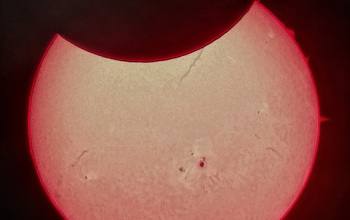Spotlighting the sun

Taken with a cell phone through a 60mm Lunt Hydrogen Alpha Telescope, this image shows off sunspots, prominences and filaments. Credit: Rob Sparks, NOAO
Astronomers with the National Science Foundation (NSF)-funded National Optical Astronomy Observatory (NOAO) captured pictures not only of Thursday's partial solar eclipse, but also of the “monster” sized active region or sun spot that has many comparing it to one of a similar size that occurred 11 years ago.
The sun spots were earlier reported by scientists with the NSF-supported National Solar Observatory. According to astronomers Frank Hill and Kiran Jain, “As of Oct 21, 2014, a very large active region is currently on the solar disk and producing flares as strong as an X1. [Solar flares are classified according to their strength, and X-class flares are the biggest.]
It is eerily reminiscent of another very large active region, which appeared almost exactly 11 years ago around Halloween 2003 very close to the same location on the sun and produced an X17 event, the largest solar flare recorded in modern history. That flare was one of a series of very strong flares now known as the Halloween flares. We may be in for an encore. This active region currently covers 2,000 millionths of the solar disk area and is almost the size of Jupiter.”
What's the significance of active regions?
When they produce X17 events with solar winds that spew solar matter full of charged particles, they can impact the Earth's ionosphere, the very upper part of our atmosphere. That's where our satellites reside, so extreme solar winds can hamper our communications systems that rely on these satellites, such as GPSs and telecommunications, as well as have impact on power grids.
Additionally, the increased solar activity makes that upper atmosphere a little hotter, which causes more wear-and-tear on the satellites. The last Halloween flares actually knocked out power grids in Sweden, so they can be cause for concern here on Earth. The current active region showed up in late September and is likely to stick around for a few weeks, so astronomers are monitoring it closely to see how it grows or changes.
And NOAO's Robert Sparks showed that sometimes all it takes is a phone camera and a telescope to provide photos with amazing detail. In two of the photos, he used cell phones attached to a telescope, providing not only a good look at the sun's active region, but also prominences (large, bright, gaseous features that extend outward from the sun's surface, often in loop shapes) and filaments (large regions of very dense, cool gas, held in place by magnetic fields that appear as dark, long and thin).
Media Contacts
Ivy F. Kupec, NSF, (703) 292-8796, ikupec@nsf.gov
Related Websites
National Optical Astronomy Observatory: http://www.noao.edu/
The National Science Foundation (NSF) is an independent federal agency that supports fundamental research and education across all fields of science and engineering. In fiscal year (FY) 2014, its budget is $7.2 billion. NSF funds reach all 50 states through grants to nearly 2,000 colleges, universities and other institutions. Each year, NSF receives about 50,000 competitive requests for funding, and makes about 11,500 new funding awards. NSF also awards about $593 million in professional and service contracts yearly.
Media Contact
More Information:
http://nsf.gov/news/news_summ.jsp?cntn_id=133135&org=NSF&from=newsAll latest news from the category: Physics and Astronomy
This area deals with the fundamental laws and building blocks of nature and how they interact, the properties and the behavior of matter, and research into space and time and their structures.
innovations-report provides in-depth reports and articles on subjects such as astrophysics, laser technologies, nuclear, quantum, particle and solid-state physics, nanotechnologies, planetary research and findings (Mars, Venus) and developments related to the Hubble Telescope.
Newest articles

NASA: Mystery of life’s handedness deepens
The mystery of why life uses molecules with specific orientations has deepened with a NASA-funded discovery that RNA — a key molecule thought to have potentially held the instructions for…

What are the effects of historic lithium mining on water quality?
Study reveals low levels of common contaminants but high levels of other elements in waters associated with an abandoned lithium mine. Lithium ore and mining waste from a historic lithium…

Quantum-inspired design boosts efficiency of heat-to-electricity conversion
Rice engineers take unconventional route to improving thermophotovoltaic systems. Researchers at Rice University have found a new way to improve a key element of thermophotovoltaic (TPV) systems, which convert heat…



